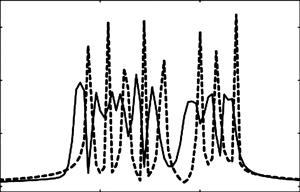Phase range finding based on digital spectral analysis of N-OFDM signals
DOI:
https://doi.org/10.3103/S0735272721070037Keywords:
phase-shift range finding, analog-to-digital conversion, discrete Fourier transform, theory of multichannel analysis, OFDM, N-OFDM, phase range finding, orthogonal signalsAbstract
The phase multifrequency methods of radar range measurements from the viewpoint of solving the problem of digital spectral analysis are proposed in this study. At present, the OFDM type orthogonal signals have gained widespread use for solving the range finding problems. However, the measurement methods based on using these signals lead to errors in range finding in the presence of Doppler frequency shift. In addition, such methods feature limited spectral efficiency and noise immunity. All this in full measure can be referred to the well-known methods of superresolution.
The fundamental distinction of the approach proposed in this paper is the use of multifrequency nonorthogonal signals (N-OFDM) in which the location of frequencies of harmonic components is not tied to maximums of the amplitude frequency characteristics (AFC) of filters synthesized by using the fast Fourier transform (FFT). The nonorthogonal signal based methods considered in this paper could be viewed as a more general case with respect to OFDM. An advantage of the proposed method is the possibility of arbitrary variations of multifrequency signal parameters, including frequencies of harmonic components (subcarriers) and the length of sample observed. It allows us to take into account the Doppler shift of subcarriers, provide for the control of range resolution magnitude and the attainable signal-to-noise ratio. Such approach makes it possible to implement an adaptive offset from frequency concentrated interference by the selection of values of subcarrier frequencies that are least susceptible to negative impact, to reduce the peak factor of multifrequency signal mixture, and improve the electromagnetic compatibility of radar equipment at the expense of signal frequency bandwidth narrowing. In addition, the nonorthogonal frequency plan prevents the communications surveillance means to determine the distance to radar using the same phase difference of subcarriers that is possible, in principle, while using the fixed frequency grid in the case of OFDM signals.
Based on the theory of multichannel analysis, the paper presents a system of equations derived that ensures the system solution in the case of several targets. The range estimation method proposed in this paper and based on the maximum likelihood can potentially guarantee the attainment of the lower Cramer-Rao bound for dispersions of unbiased estimates of signal parameters. In this case, all the other methods of superresolution with respect to the maximum likelihood method are known to be quasioptimal.
References
A. G. Saibel, Introduction to Radio Range Finding, [in Russian]. Moscow: Oborongiz, 1960.
V. V. Vasin, O. V. Vlasov, V. V. Grigorin-Ryabov, Radar Installations (Theory and Design Principles), [in Russian]. Moscow: Sov. Radio, 1970.
K. Iizuka, A. P. Freundorfer, “Detection of nonmetallic buried objects by a step frequency radar,” Proc. IEEE, vol. 71, no. 2, pp. 276–279, 1983, doi: https://doi.org/10.1109/PROC.1983.12572.
Y. Liu, J. Yi, X. Wan, X. Zhang, H. Ke, “Time varying clutter suppression in CP OFDM based passive radar for slowly moving targets detection,” IEEE Sensors J., vol. 20, no. 16, pp. 9079–9090, 2020, doi: https://doi.org/10.1109/JSEN.2020.2986717.
T. Bai, N. Zheng, S. Chen, “OFDM MIMO radar waveform design for targets identification,” ETRI J., vol. 40, no. 5, pp. 592–603, 2018, doi: https://doi.org/10.4218/etrij.2018-0010.
V. I. Slyusar, “Frequency selection of high-speed group targets in the case of accumulation of echo signals,” Radioelectron. Commun. Syst., vol. 43, no. 8, pp. 43–46, 2000.
V. I. Slyusar, K. A. Vasil’ev, “Potential limits of frequency division multiplexing of N-OFDM signals based on Hartley’s basis functions,” Radioelectron. Commun. Syst., vol. 51, no. 3, pp. 129–133, 2008, doi: https://doi.org/10.3103/S0735272708030035.
O. N. Soloshchev, V. I. Slyusar, V. V. Tverdokhlebov, “Phase method of range measuring based on the theory of multichannel analysis,” Artilleriiskoe i Strelkovoe Vooruz., no. 2, pp. 29–32, 2007.
V. A. Varyukhin, Foundations of Multichannel Analysis Theory, [in Russian]. Kiev: VA PVO SV, 1993.
V. V. Abramenkov, Measurement of Coordinates of Radar Targets Using the Methods of Multisignal Radio Location, [in Russian]. Smolensk: VU VPVO VS RF, 2002.
J. Max, Methodes et techniques de traitement du signal et applications aux mesures physiques. Tome 1. Principes generaux et methodes classiques, [in French]. Paris-New York-Barselone-Milan-Mexico-Rio de Janeiro: Masson, 1981.
G. A. Korn, T. M. Korn, Mathematical Handbook for Scientists and Engineers: Definitions, Theorems, and Formulas for Reference and Review. New York, NY: McGraw-Hill, 1961.
X. Gu, Y. Zhang, “Resolution threshold analysis of MUSIC algorithm in radar range imaging,” Prog. Electromagn. Res. B, vol. 31, pp. 297–321, 2011, doi: https://doi.org/10.2528/PIERB11040806.
M. Bondarenko, V. I. Slyusar, “Influence of jitter in ADC on precision of direction-finding by digital antenna arrays,” Radioelectron. Commun. Syst., vol. 54, no. 8, pp. 436–445, 2011, doi: https://doi.org/10.3103/S0735272711080061.
V. I. Slyusar et al., “An above-water testing’s result of experimental surveillance radar with 64-channels digital antenna array,” in 2010 International WaterSide Security Conference, 2010, pp. 1–4, doi: https://doi.org/10.1109/WSSC.2010.5730282.
А. I. Мinochkin, V. I. Slyusar, V. I. Rudakov, Theoretical Bases of Military-Technical Researches. Vol. 1, [in Russian]. Kyiv: Granmna, 2012.
V. I. Slyusar, O. O. Trocko, “Method for advancing compensation of Doppler effect at transfer of OFDM signals,” Patent UA46668U. IPK G01S 7/36, H03D 13/00, 2009.
V. A. Varyukhin, V. I. Pokrovskii, V. F. Sakhno, “Modified likelihood function in the problem of determining the angular coordinates of sources using antenna array,” Dokl. AN SSSR, vol. 270, no. 5, pp. 1092–1094, 1983.
S. Fortunati, L. Sanguinetti, F. Gini, M. S. Greco, B. Himed, “Massive MIMO radar for target detection,” IEEE Trans. Signal Process., vol. 68, pp. 859–871, 2020, doi: https://doi.org/10.1109/TSP.2020.2967181.
M. Temiz, E. Alsusa, L. Danoon, “A receiver architecture for dual-functional massive MIMO OFDM RadCom systems,” in 2020 IEEE International Conference on Communications Workshops (ICC Workshops), 2020, pp. 1–6, doi: https://doi.org/10.1109/ICCWorkshops49005.2020.9145285.
C. D’Andrea, S. Buzzi, M. Lops, “Communications and radar coexistence in the massive MIMO regime: Uplink analysis,” IEEE Trans. Wirel. Commun., vol. 19, no. 1, pp. 19–33, 2020, doi: https://doi.org/10.1109/TWC.2019.2939816.


